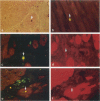Abstract
It is often speculated that progressive deterioration of left ventricular function in heart failure is due to ongoing loss of viable cardiocytes. In this study, we examined the possibility that cardiocyte loss in heart failure may be due, in part, to apoptosis, an active process of gene-directed cellular self-destruction. Studies were performed in left ventricular tissue obtained from 10 dogs with chronic heart failure produced by multiple intracoronary microembolizations (left ventricular ejection fraction 27 +/- 1%) and from 5 normal dogs. Evidence for cardiocyte apoptosis was based on transmission electron microscopy criteria and on in situ immunohistochemical labeling of nuclear DNA fragmentation. There was no evidence of apoptotic cardiocytes in normal dogs. Features of cardiocyte apoptosis were observed in dogs with heart failure primarily in regions bordering old infarcts. Electron microscopic features of cardiocyte apoptosis included (1) intact sarcolemma and inner organelles in the presence of compaction and segregation of nuclear chromatin into sharply delineated masses that about the nuclear envelope, (2) intact sarcolemma in the presence of cytoplasm shrinkage, blebbing, and nuclear fragmentation, and (3) intact sarcolemma in the presence of complete disorganization of inner organelles and disappearance of nucleolemma. A count of all of the apoptotic bodies positively labeled for nuclear DNA fragments showed that 11% were of cardiocyte origin confirmed by positive labeling with striated muscle antimyosin antibody. We conclude that morphological and biochemical features of cardiocyte apoptosis exist in the left ventricular myocardium of dogs with chronic heart failure.
Full text
PDF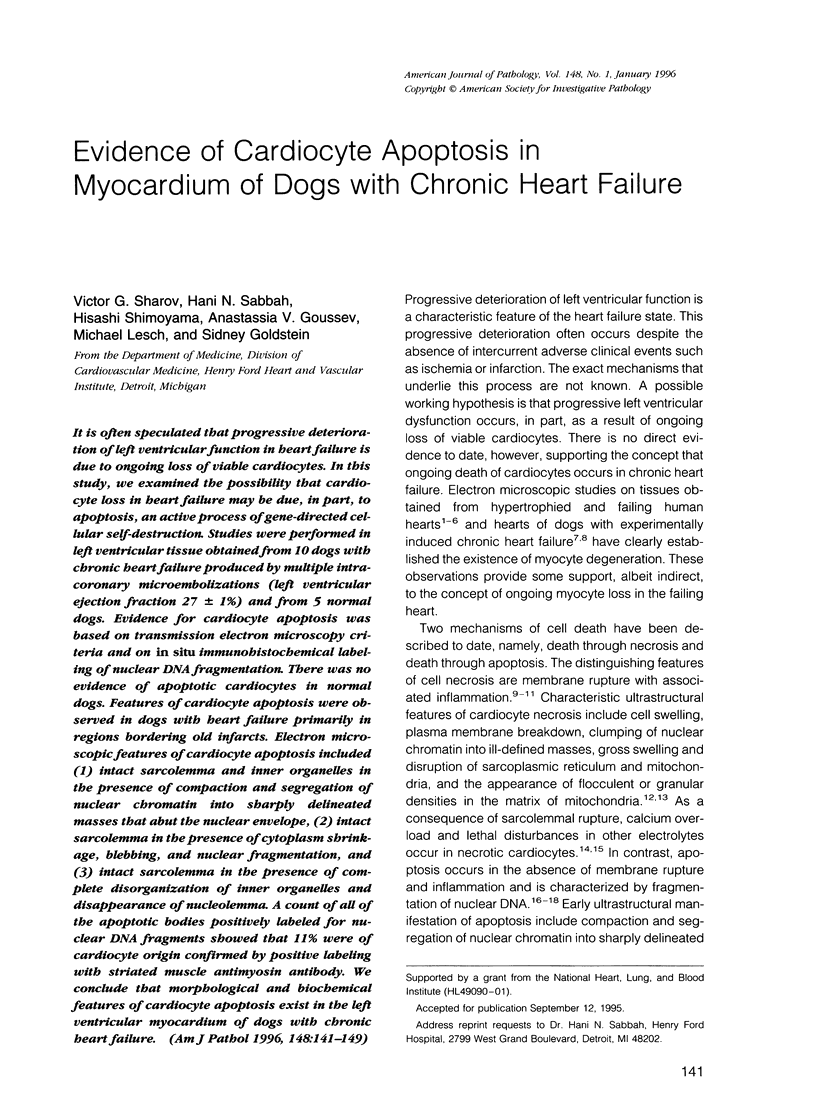
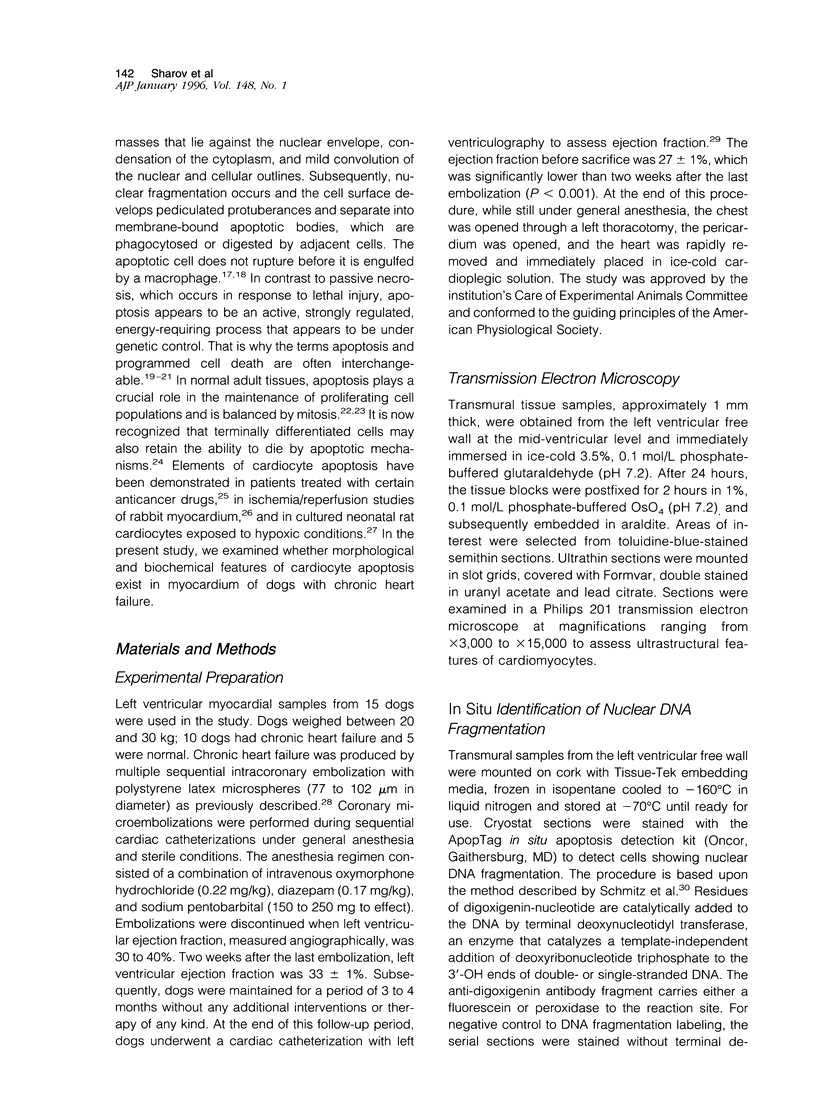
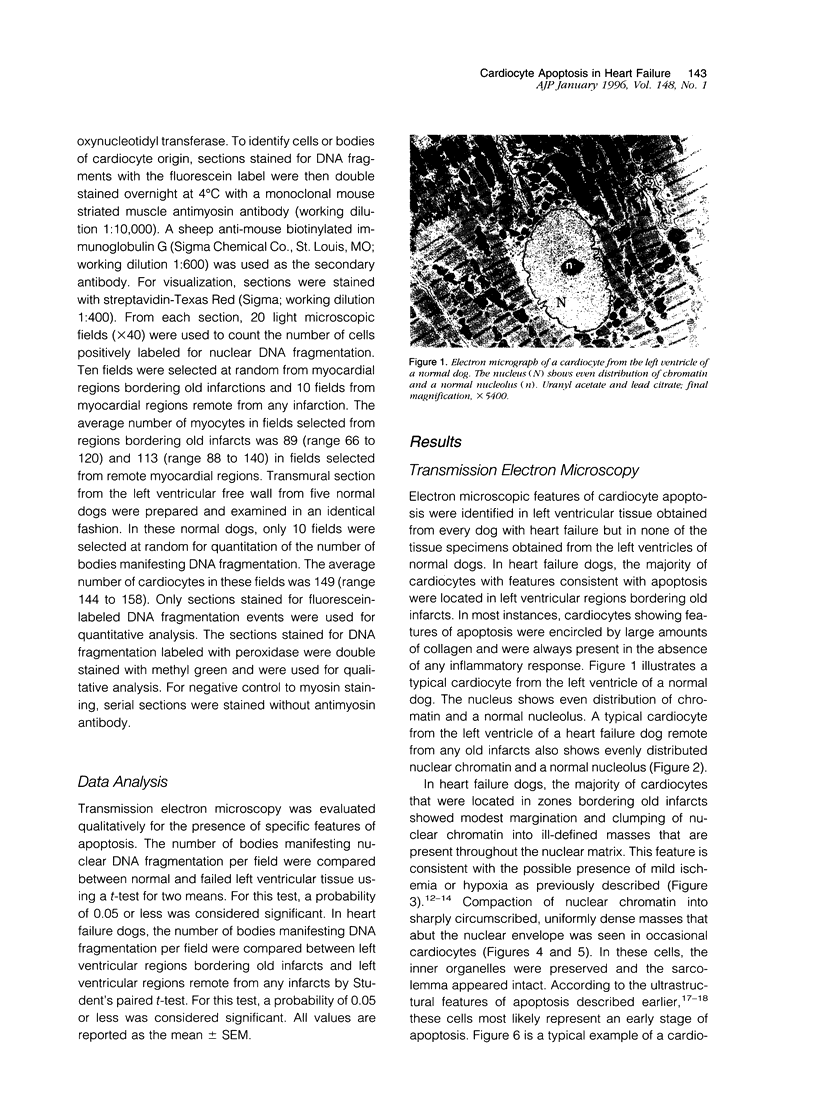
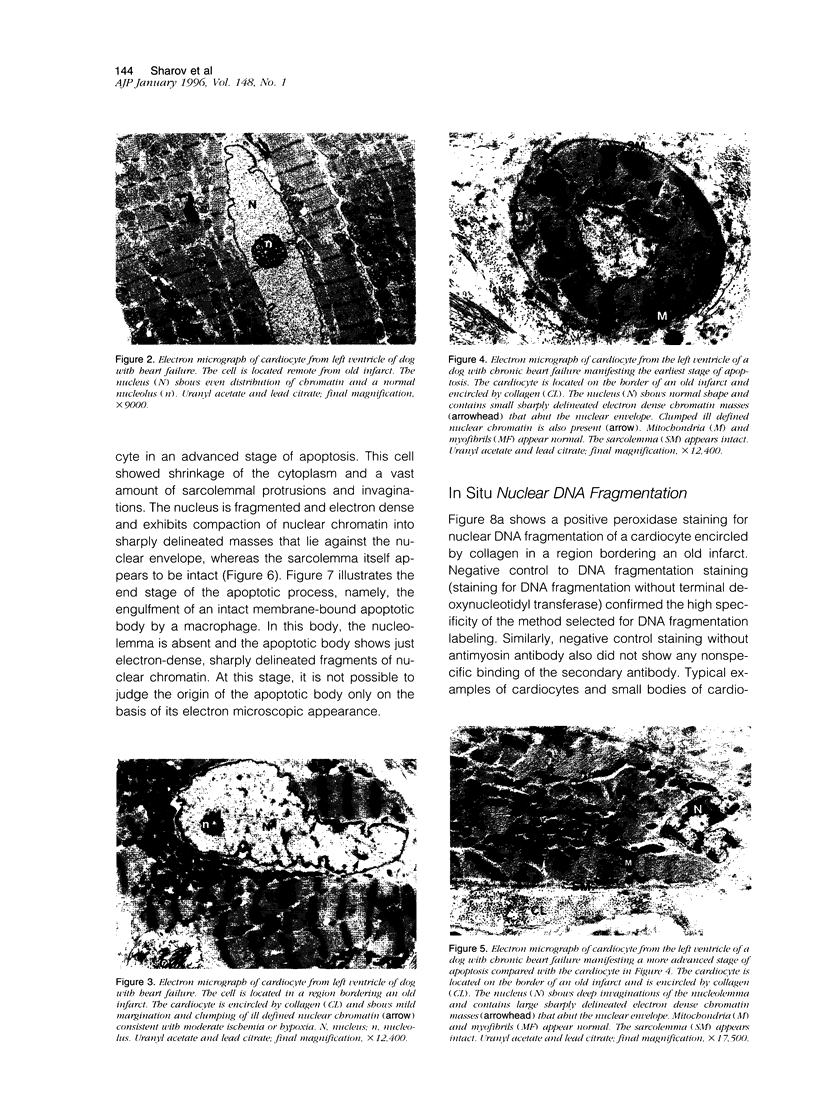
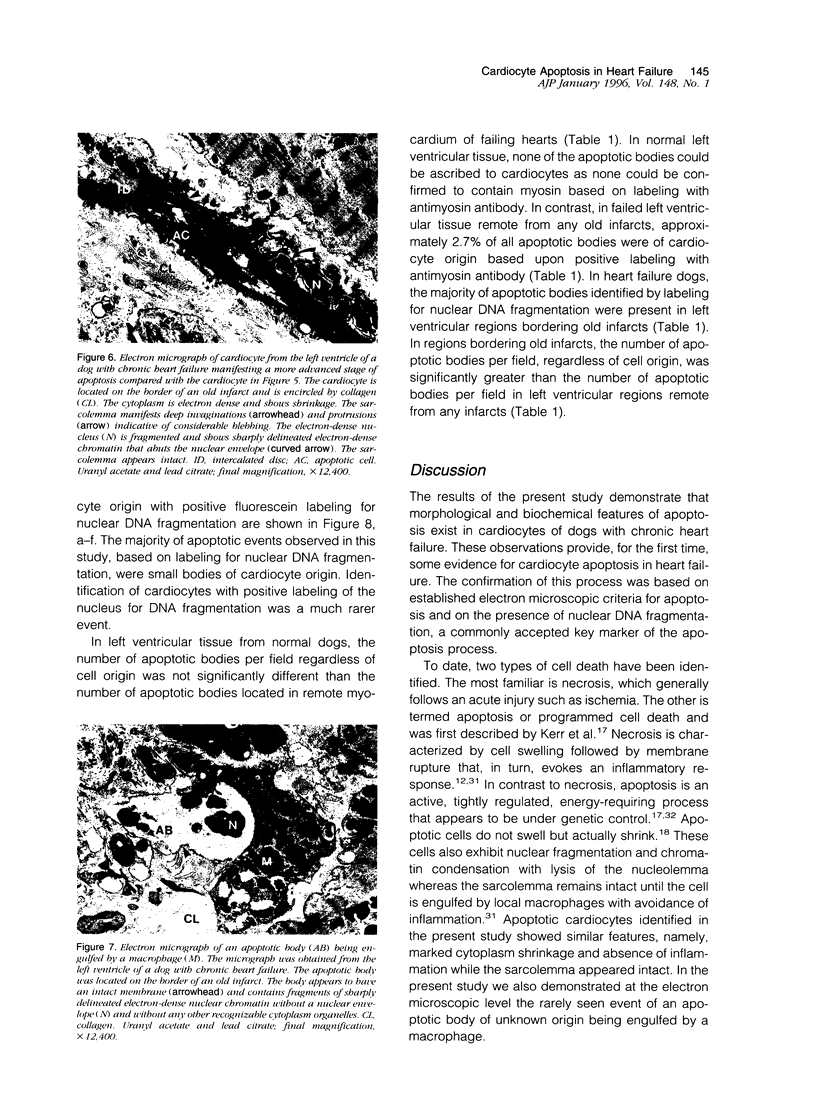
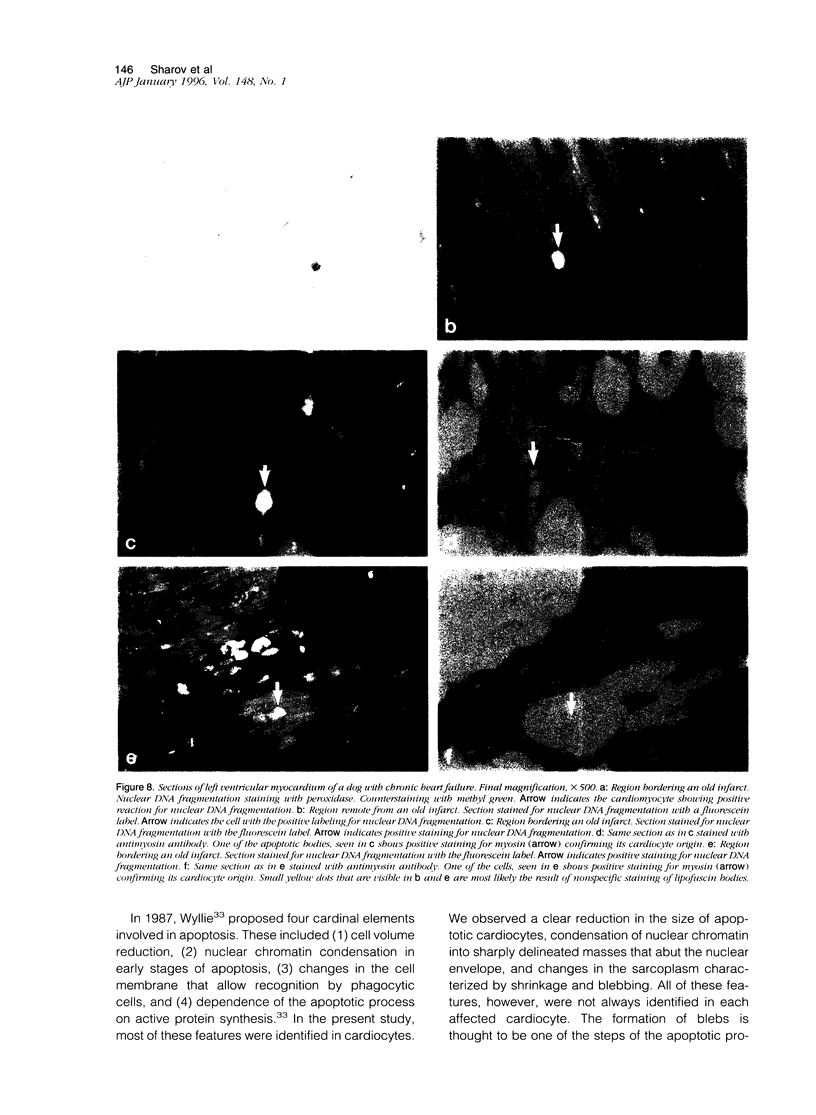
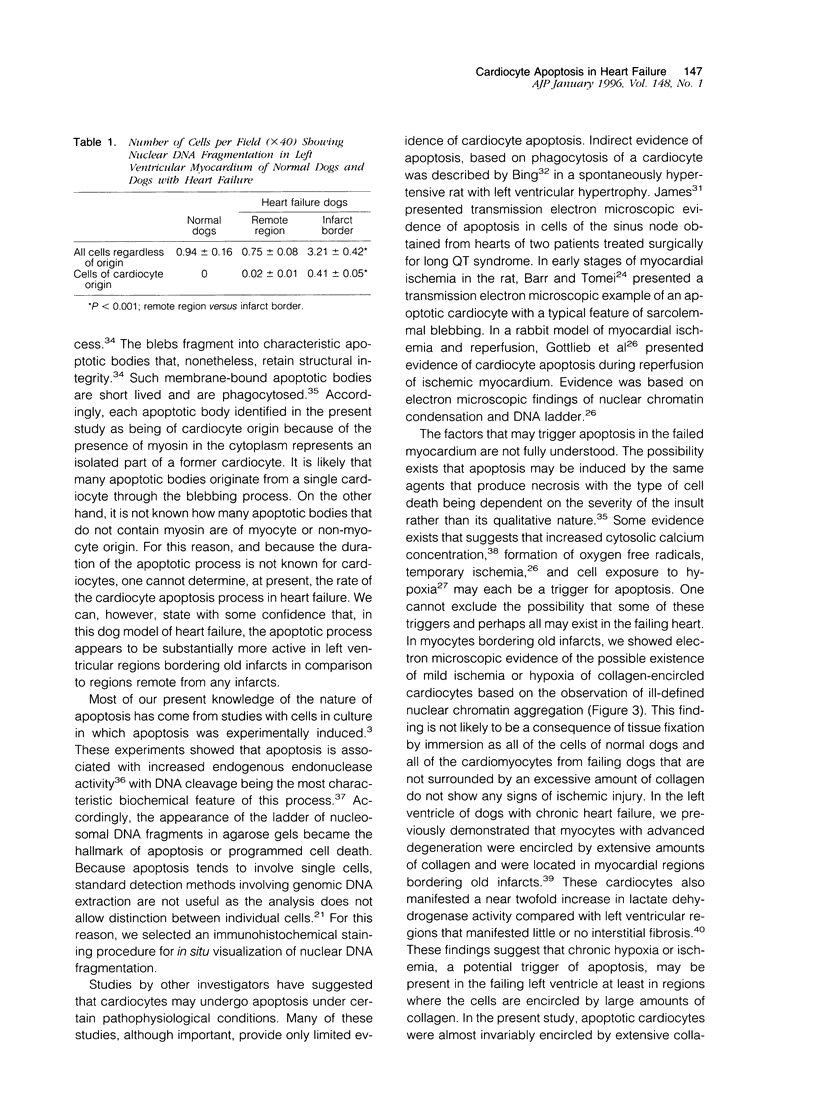
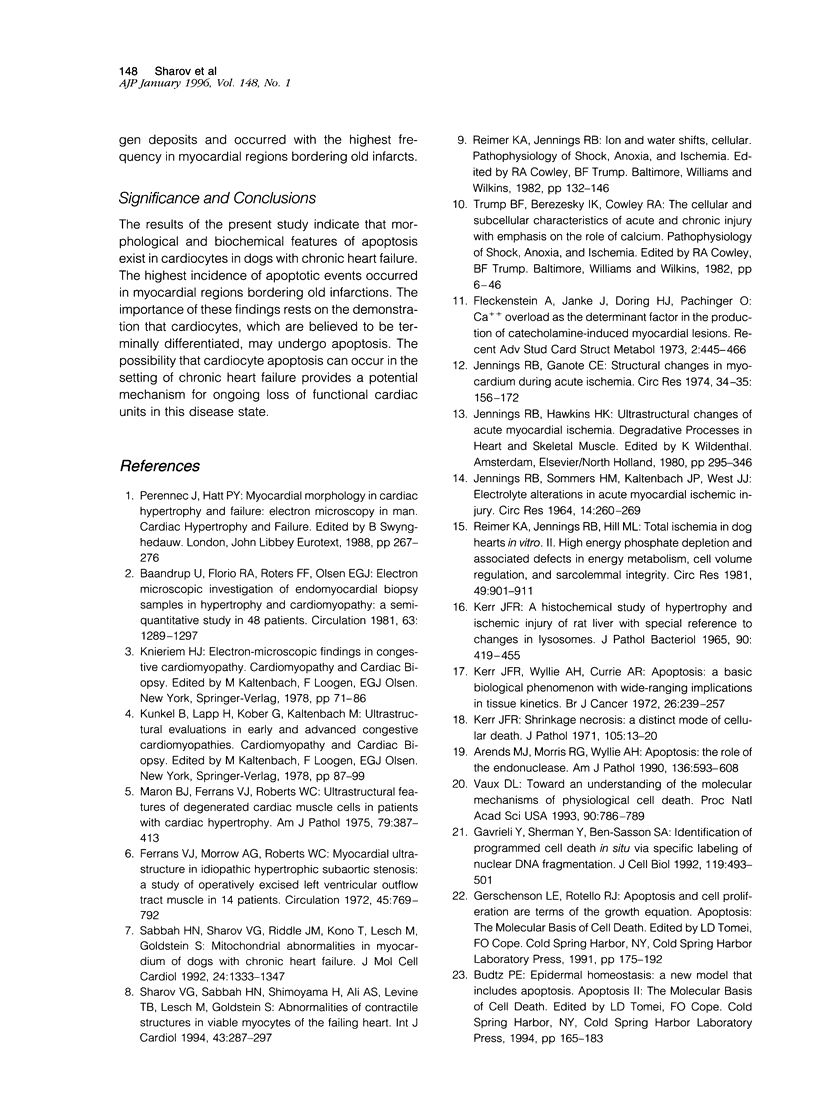
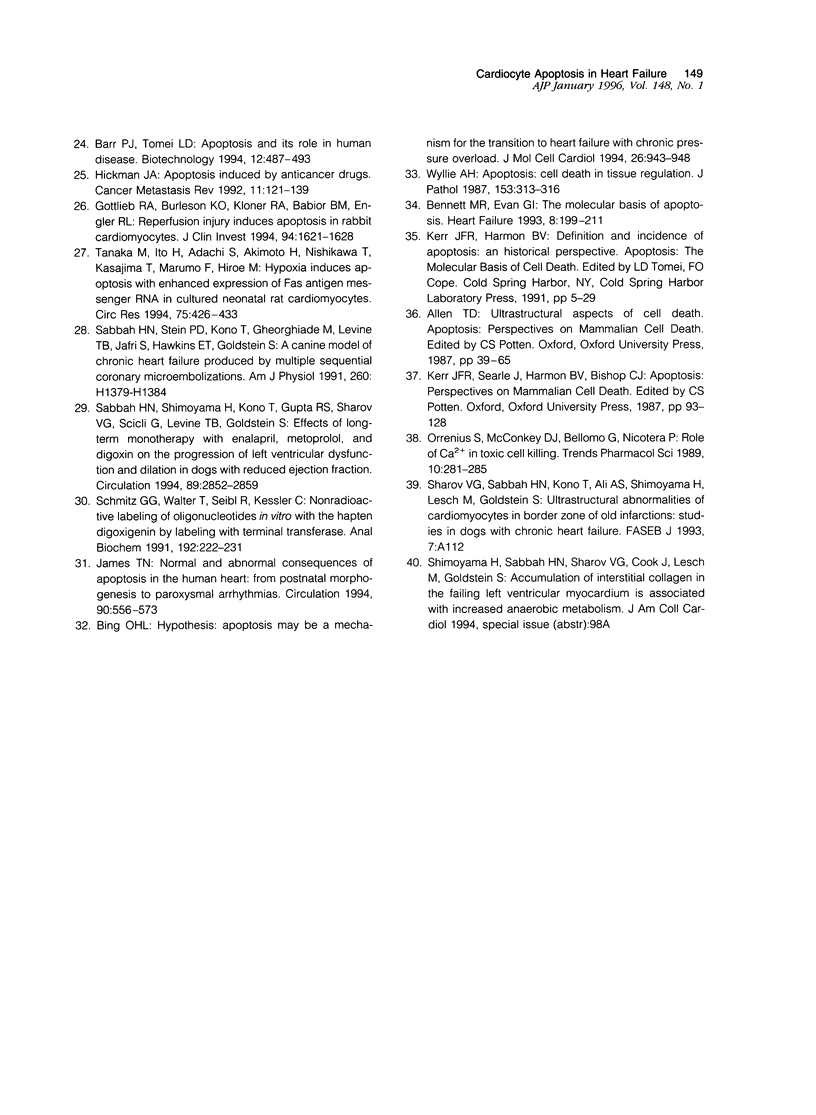
Images in this article
Selected References
These references are in PubMed. This may not be the complete list of references from this article.
- Arends M. J., Morris R. G., Wyllie A. H. Apoptosis. The role of the endonuclease. Am J Pathol. 1990 Mar;136(3):593–608. [PMC free article] [PubMed] [Google Scholar]
- Baandrup U., Florio R. A., Roters F., Olsen E. G. Electron microscopic investigation of endomyocardial biopsy samples in hypertrophy and cardiomyopathy. A semiquantitative study in 48 patients. Circulation. 1981 Jun;63(6):1289–1298. doi: 10.1161/01.cir.63.6.1289. [DOI] [PubMed] [Google Scholar]
- Barr P. J., Tomei L. D. Apoptosis and its role in human disease. Biotechnology (N Y) 1994 May;12(5):487–493. doi: 10.1038/nbt0594-487. [DOI] [PubMed] [Google Scholar]
- Bing O. H. Hypothesis: apoptosis may be a mechanism for the transition to heart failure with chronic pressure overload. J Mol Cell Cardiol. 1994 Aug;26(8):943–948. doi: 10.1006/jmcc.1994.1115. [DOI] [PubMed] [Google Scholar]
- Ferrans V. J., Morrow A. G., Roberts W. C. Myocardial ultrastructure in idiopathic hypertrophic subaortic stenosis. A study of operatively excised left ventricular outflow tract muscle in 14 patients. Circulation. 1972 Apr;45(4):769–792. doi: 10.1161/01.cir.45.4.769. [DOI] [PubMed] [Google Scholar]
- Fleckenstein A., Janke J., Döring H. J., Pachinger O. Ca overload as the determinant factor in the production of catecholamine-induced myocardial lesions. Recent Adv Stud Cardiac Struct Metab. 1973;2:455–466. [PubMed] [Google Scholar]
- Gavrieli Y., Sherman Y., Ben-Sasson S. A. Identification of programmed cell death in situ via specific labeling of nuclear DNA fragmentation. J Cell Biol. 1992 Nov;119(3):493–501. doi: 10.1083/jcb.119.3.493. [DOI] [PMC free article] [PubMed] [Google Scholar]
- Gottlieb R. A., Burleson K. O., Kloner R. A., Babior B. M., Engler R. L. Reperfusion injury induces apoptosis in rabbit cardiomyocytes. J Clin Invest. 1994 Oct;94(4):1621–1628. doi: 10.1172/JCI117504. [DOI] [PMC free article] [PubMed] [Google Scholar]
- Hickman J. A. Apoptosis induced by anticancer drugs. Cancer Metastasis Rev. 1992 Sep;11(2):121–139. doi: 10.1007/BF00048059. [DOI] [PubMed] [Google Scholar]
- JENNINGS R. B., SOMMERS H. M., KALTENBACH J. P., WEST J. J. ELECTROLYTE ALTERATIONS IN ACUTE MYOCARDIAL ISCHEMIC INJURY. Circ Res. 1964 Mar;14:260–269. doi: 10.1161/01.res.14.3.260. [DOI] [PubMed] [Google Scholar]
- James T. N. Normal and abnormal consequences of apoptosis in the human heart. From postnatal morphogenesis to paroxysmal arrhythmias. Circulation. 1994 Jul;90(1):556–573. [PubMed] [Google Scholar]
- Jennings R. B., Ganote C. E. Structural changes in myocardium during acute ischemia. Circ Res. 1974 Sep;35 (Suppl 3):156–172. [PubMed] [Google Scholar]
- Kerr J. F. A histochemical study of hypertrophy and ischaemic injury of rat liver with special reference to changes in lysosomes. J Pathol Bacteriol. 1965 Oct;90(2):419–435. doi: 10.1002/path.1700900210. [DOI] [PubMed] [Google Scholar]
- Kerr J. F. Shrinkage necrosis: a distinct mode of cellular death. J Pathol. 1971 Sep;105(1):13–20. doi: 10.1002/path.1711050103. [DOI] [PubMed] [Google Scholar]
- Kerr J. F., Wyllie A. H., Currie A. R. Apoptosis: a basic biological phenomenon with wide-ranging implications in tissue kinetics. Br J Cancer. 1972 Aug;26(4):239–257. doi: 10.1038/bjc.1972.33. [DOI] [PMC free article] [PubMed] [Google Scholar]
- Maron B. J., Ferrans V. J., Roberts W. C. Ultrastructural features of degenerated cardiac muscle cells in patients with cardiac hypertrophy. Am J Pathol. 1975 Jun;79(3):387–434. [PMC free article] [PubMed] [Google Scholar]
- Orrenius S., McConkey D. J., Bellomo G., Nicotera P. Role of Ca2+ in toxic cell killing. Trends Pharmacol Sci. 1989 Jul;10(7):281–285. doi: 10.1016/0165-6147(89)90029-1. [DOI] [PubMed] [Google Scholar]
- Reimer K. A., Jennings R. B., Hill M. L. Total ischemia in dog hearts, in vitro 2. High energy phosphate depletion and associated defects in energy metabolism, cell volume regulation, and sarcolemmal integrity. Circ Res. 1981 Oct;49(4):901–911. doi: 10.1161/01.res.49.4.901. [DOI] [PubMed] [Google Scholar]
- Sabbah H. N., Sharov V., Riddle J. M., Kono T., Lesch M., Goldstein S. Mitochondrial abnormalities in myocardium of dogs with chronic heart failure. J Mol Cell Cardiol. 1992 Nov;24(11):1333–1347. doi: 10.1016/0022-2828(92)93098-5. [DOI] [PubMed] [Google Scholar]
- Sabbah H. N., Shimoyama H., Kono T., Gupta R. C., Sharov V. G., Scicli G., Levine T. B., Goldstein S. Effects of long-term monotherapy with enalapril, metoprolol, and digoxin on the progression of left ventricular dysfunction and dilation in dogs with reduced ejection fraction. Circulation. 1994 Jun;89(6):2852–2859. doi: 10.1161/01.cir.89.6.2852. [DOI] [PubMed] [Google Scholar]
- Sabbah H. N., Stein P. D., Kono T., Gheorghiade M., Levine T. B., Jafri S., Hawkins E. T., Goldstein S. A canine model of chronic heart failure produced by multiple sequential coronary microembolizations. Am J Physiol. 1991 Apr;260(4 Pt 2):H1379–H1384. doi: 10.1152/ajpheart.1991.260.4.H1379. [DOI] [PubMed] [Google Scholar]
- Schmitz G. G., Walter T., Seibl R., Kessler C. Nonradioactive labeling of oligonucleotides in vitro with the hapten digoxigenin by tailing with terminal transferase. Anal Biochem. 1991 Jan;192(1):222–231. doi: 10.1016/0003-2697(91)90212-c. [DOI] [PubMed] [Google Scholar]
- Sharov V. G., Sabbah H. N., Shimoyama H., Ali A. S., Levine T. B., Lesch M., Goldstein S. Abnormalities of contractile structures in viable myocytes of the failing heart. Int J Cardiol. 1994 Mar 1;43(3):287–297. doi: 10.1016/0167-5273(94)90209-7. [DOI] [PubMed] [Google Scholar]
- Tanaka M., Ito H., Adachi S., Akimoto H., Nishikawa T., Kasajima T., Marumo F., Hiroe M. Hypoxia induces apoptosis with enhanced expression of Fas antigen messenger RNA in cultured neonatal rat cardiomyocytes. Circ Res. 1994 Sep;75(3):426–433. doi: 10.1161/01.res.75.3.426. [DOI] [PubMed] [Google Scholar]
- Vaux D. L. Toward an understanding of the molecular mechanisms of physiological cell death. Proc Natl Acad Sci U S A. 1993 Feb 1;90(3):786–789. doi: 10.1073/pnas.90.3.786. [DOI] [PMC free article] [PubMed] [Google Scholar]
- Wyllie A. H. Apoptosis: cell death in tissue regulation. J Pathol. 1987 Dec;153(4):313–316. doi: 10.1002/path.1711530404. [DOI] [PubMed] [Google Scholar]










